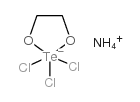CHEMICAL IDENTIFICATION
-
RTECS NUMBER :
-
WY2310000
-
CHEMICAL NAME :
-
Tellurate(1-), (1,2-ethanediolato(2-)-O,O')trichloro-, ammonium, (SP-5-22)-
-
CAS REGISTRY NUMBER :
-
106566-58-9
-
LAST UPDATED :
-
199707
-
DATA ITEMS CITED :
-
3
-
MOLECULAR FORMULA :
-
C2-H4-Cl3-O2-Te.H4-N
-
MOLECULAR WEIGHT :
-
312.06
HEALTH HAZARD DATA
ACUTE TOXICITY DATA
-
TYPE OF TEST :
-
LD50 - Lethal dose, 50 percent kill
-
ROUTE OF EXPOSURE :
-
Intravenous
-
SPECIES OBSERVED :
-
Rodent - rat
-
DOSE/DURATION :
-
5 mg/kg
-
TOXIC EFFECTS :
-
Tumorigenic - active as anti-cancer agent
-
REFERENCE :
-
NICRDR Natural Immunity and Cell Growth Regulation. (S. Karger Publishers, Inc., 79 Fifth Ave., New York, NY 10003 USA) V.3- 1984- Volume(issue)/page/year: 7,163,1988
-
TYPE OF TEST :
-
LD50 - Lethal dose, 50 percent kill
-
ROUTE OF EXPOSURE :
-
Intramuscular
-
SPECIES OBSERVED :
-
Rodent - rat
-
DOSE/DURATION :
-
10 mg/kg
-
TOXIC EFFECTS :
-
Tumorigenic - active as anti-cancer agent
-
REFERENCE :
-
NICRDR Natural Immunity and Cell Growth Regulation. (S. Karger Publishers, Inc., 79 Fifth Ave., New York, NY 10003 USA) V.3- 1984- Volume(issue)/page/year: 7,163,1988 ** OTHER MULTIPLE DOSE TOXICITY DATA **
-
TYPE OF TEST :
-
TDLo - Lowest published toxic dose
-
ROUTE OF EXPOSURE :
-
Intraperitoneal
-
SPECIES OBSERVED :
-
Rodent - rat
-
DOSE/DURATION :
-
96 mg/kg/4W-I
-
TOXIC EFFECTS :
-
Sense Organs and Special Senses (Eye) - retinal changes (pigmentary depositions, retinitis, other)
-
REFERENCE :
-
TOPADD Toxicologic Pathology. (c/o Dr. F.A. de la Iglesia, Warner-Lambert Co., Pharmaceutical Research Div., POB 1047, Ann Arbor, MI 48106) V.6(3/4)- 1978- Volume(issue)/page/year: 17,799,1989
|
